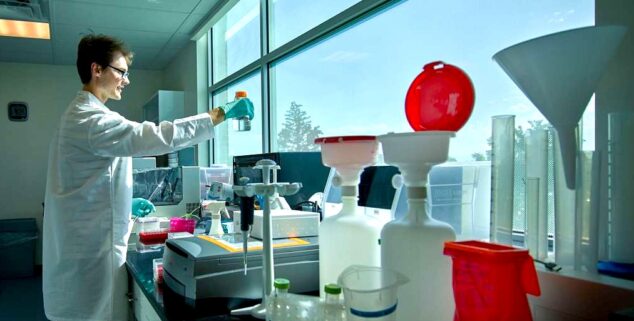News
$23 Billion Scientific Research Program Proposed in California
 A scientist studies a beeker containing cell samples at the Gates Center for Regenerative Medicine, a series of laboratories working with stem-cell biology at the University of Colorado's Anschutz Medical Campus in Denver. Gates Frontiers Fund Colorado Collection within the Carol M. Highsmith Archive, Library of Congress, Prints and Photographs Division.
A scientist studies a beeker containing cell samples at the Gates Center for Regenerative Medicine, a series of laboratories working with stem-cell biology at the University of Colorado's Anschutz Medical Campus in Denver. Gates Frontiers Fund Colorado Collection within the Carol M. Highsmith Archive, Library of Congress, Prints and Photographs Division.
California would see the creation of a $23 billion state research agency under legislation proposed late last week, a new enterprise that could threaten the existence of the state’s 20-year-old stem cell and gene therapy program.
The legislation would support research ranging from wildfire prevention to autism. It would be embedded within existing state departments and be more subject to the vagaries of gubernatorial control than the existing California Institute for Regenerative Medicine (CIRM), which is more screened off.
The funding for the new plan would dwarf the $3.6 billion that CIRM has left to finance stem cell and gene therapies. However, researchers in those areas would have to compete for dollars with scientists — not only in such areas as wildfire prevention, but also in climate change, marine ecosystems, the “nation’s food supply and cosmetics,” and unspecified “emerging technologies.”
Those areas and more are listed in the proposed bond measure.
The state would have to borrow the $23 billion to finance the new enterprise, which would be dubbed the California Foundation for Science and Health Research. The amount would be the largest bond measure ever placed before state voters.
In 2020, CIRM was saved from financial extinction when voters awarded it $5.5 billion on top of the original $3 billion in 2004 when they created CIRM through a ballot initiative. When its remaining $3.6 billion starts to run out in a few years, it will likely have to ask voters for more cash or face closing its doors.
At that future point, CIRM could well seem redundant and unnecessary to voters unless it can make a solid case otherwise.
The legislation (SB607) was introduced last Friday by state Sen. Scott Wiener, D-San Francisco, and Assemblyman Jose Luis Solache, Jr., D-Lakewood. The bond measure requires a two-thirds vote of both houses of the legislature and the governor’s signature, a majority that the Democrats hold today.
If the proposal clears the legislature next year, it would go on the ballot next June for voter approval. Only a majority vote is required for approval.
Wiener did not promote his bill with the usual press release. The first news about it appeared in a story late Friday in the New York Times.
As of this writing, no articles have appeared in California media about Wiener’s legislation. The Times article likely reflected a PR strategy behind the legislation that focuses heavily on delivering a message to President Trump.
The proposal was immediately endorsed by the United Auto Workers, which represents tens of thousands of graduate students and other academic workers, according to the Times article by Shawn Hubler and Alan Blinder. The bill stipulates that one member of the governing board be a “graduate-level researcher” and another a “postdoctoral scholar.”
In an interview with The Times, Wiener said, “As Trump and his cronies destroy federal science capacity and slash research funding for universities, California should double down on our global leadership on science.
“Scientific research is one of the pillars of the California economy.”
Wiener’s proposal in some ways mirrors the state stem cell agency, which is also funded by money that the state borrows (bonds). But the legislation’s scope is much broader and also includes financing of research facilities.
The measure proposes to split the $23 billion between construction and research. But it has not specified dollar amounts.
CIRM initially funded construction with $272 million, but no longer has a construction effort of that size.
The new foundation’s governance structure is also significantly different. It would come under the purview of the state director of government operations, a gubernatorial appointee. CIRM was designed to avoid political tinkering by lawmakers and the governor.
A governing council would be named by the state director of government operations, who would also oversee the process of selecting a “director” of the foundation. The council would approve the awards via a peer review process.
The board/council would consist of 10 to 13 members, with the majority being scientists and two coming from the “public.” The University of California also would have one seat and the state college system another. CIRM has a 35-member board.
The state secretary of governmental operations would appoint the new foundation’s board. The Government Operations Agency includes 13 departments with more than 22,000 employees.
Details of the legislation are subject to change, perhaps radically, as Wiener attempts to gather the support necessary to win legislative approval and position it for winning voter approval in June. Democrats have an overwhelming majority in the legislature.
Wiener might well adopt some language from the 17,000-word ballot initiative that created CIRM and that now controls its current processes.
Last March, Wiener authored a related (SB829) bill that remains in the Senate legislative process. His office has not responded to multiple inquiries about how he intends to proceed with that measure.
David Jensen is a retired newsman and has covered CIRM for 20 years on his newsletter, the California Stem Cell Report. He authored the book, “California’s Great Stem Cell Experiment,” in 2020.
Want to see more stories like this? Sign up for The Roundup, the free daily newsletter about California politics from the editors of Capitol Weekly. Stay up to date on the news you need to know.
Sign up below, then look for a confirmation email in your inbox.

Leave a Reply